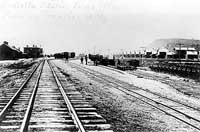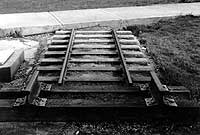|
Page
59
|
Demise of Eagle Rock
As east-west traffic
increased, Oregon Short Line became the dominant road. Utah & Northern was
having labor troubles. A wind storm in 1886 that destroyed the roundhouse in
Eagle Rock was utilized as the excuse for moving the headquarters to Pocatello.
The facilities at Eagle Rock were closed and in July and August, 1887, everything
which could be put on flat cars was moved to Pocatello. When most of its adult
population left town (the number of residents was reduced from about 2,000 to
400), Eagle Rock nearly disappeared. The remaining citizens reorganized the
community, adopting the new name of Idaho Falls by referendum in 1890. Now in
the late 20th century, with huge Federal expenditures and employment at the
Idaho National Engineering Laboratory, Idaho Falls vies with Pocatello for the
place as Idaho's second city.
|
One shipper from Omaha, in a letter to his old Civil War buddy L.Q.C. Lamar, Secretary of the Interior, observed that maybe there were trespassers not on the right-of-way, but as anyone who had been to Pocatello knew, the buildings
|
Enlargement of the Pocatello
Townsite
Soon after its founding
in 1882, the forty acre terminal grounds at Pocatello became very crowded. Oregon
Short Line made Pocatello a main terminal and built a round house, shop facilities
and a coaling station. Also, between the tracks, in the center of the operation,
were constructed the Pacific Hotel and the freight depot.
A row of permanent houses lined "Company Row" along the west right-of-way boundary, but many employees could not find a place to live on railway property.
Because Pocatello Junction had been carved out of the Indian Reservation, there was no private land around the station grounds and anyone who lived off the right-of-way was a trespasser on the Reservation. Frequently Agency police tore down or burned structures on the Reservation. Nonetheless, as early as 1885, many of the local businesses and the homes of the people who ran them were outside the right-of-way, in trespass on the Reservation. The rest of the white man's activities were in trespass on the reservation. There were no saloons on the reservation (this would have been a violation of the Indian Intercourse Act), but there was a bar in the Pacific House Hotel on Oregon Short Line-owned property, opened in 1883.
An order was issued by the Secretary of the Interior in late 1885 to clear the land once and for all of the parties "unlawfully and improperly" on the Reservation. Implementation of this order was delayed time and again because there was a need for the workers and the services provided and nowhere else for them to go.
|
The Indian Agent wrote the Commissioner of Indian Affairs that the Justice of the Peace was young, sober, industrious and a good citizen. Furthermore:
|
Even the Federal justice of the peace assigned to maintain law and order in the area lived on the Reservation and was a trespasser, although he did hold court in a box car on the right-of-way.
In the fall of 1886, a petition signed by 41 persons, mainly railway employees, was sent to the Bureau of Indian Affairs seeking permission for them to stay on Reservation land until Congress could provide more space. In warm weather, they said, it was agreeable to live in tents wherever they could pitch them but now, with winter at hand, they needed houses to protect themselves "from the awful cold of the Idaho winter." In 1887, a report was sent to the Secretary f the Interior that Pocatello's population was then around 1,500 persons and a list was furnished of 60 buildings or structures built on Reservation land. The list included laundries, carpenter shops, butcher shops, the house of the justice of the peace, barber shops, a wholesale grocery, Keeney's stable, a barn, blacksmith's shop, warehouses, restaurants and a number of residences. Interestingly, no churches were included.
In order to give validity to the efforts of the justice of the peace, requests for exception to the order to clear all trespassers from the Reservation were made.
 |
| View looking south at the Ramsey Transfer apparatus, (in center of photo, with men working, to the right of the second main line) Pocatello, Idaho, (June, 1886). To the right is "Company Row" along North Harrison Ave. Beyond it is the quartzite hill on the southwest side of the Portneuf River, on the Fort Hall Indian Reservation. The Ramsey Transfer involved jacking railcars up and placing wheels of different gauges under them. Note the mainlines have three rails. The freight house is to the left, with the Pacific Hotel (without Mansard Roof) behind it. Abe Lillibridge collection, Idaho State University. |
 |
| Monument on Idaho State University campus, in front of the Liberal Arts Building, showing standard-gauge and narrow-gauge rails. Monument was erected in 1963 during the Idaho Territory Centennial celebration, and lies on the original narrow-gauge right-of-way, (June, 1992). |
Throughout this period of tension between the Railway, the employees, the Indians and the Department of the Interior, the correspondence among the various parties seemed to assume that only Utah & Northern was involved. It is seldom mentioned that Oregon Short Line was the operator of the railway and the employer of the trespassers and that its business was what had brought these people and businesses to the area. Perhaps the illegality of Utah & Northern's right-of-way on the Reservation and the continuing dispute over its failure to pay compensation therefor exacerbated the dispute. But things were rapidly reaching the condition where a solution had to be found. Conditions were made even worse in 1887 when Utah & Northern moved its headquarters from Eagle Rock to Pocatello Junction. Some houses were moved onto the right-of-way, even further reducing the available space.
In May, 1887, a treaty was signed ceding additional right-of-way to the railroads and setting aside 1,840 acres for a townsite. The treaty was ratified on September 1, 1888, finally legitimizing what Oregon Short Line had begun in 1882, when it called its Reservation home Pocatello Junction. The townsite was surveyed and divided into lots which were sold at public auction in 1891.
Merger of the Two Railroads
Ultimately, the
two railroads combined and in 1889 became the Oregon Short Line & Utah Northern
Railway Company. The new combined railroad, along with the parent Union Pacific
Railway Company, fell on hard times and both entered receivership in 1893,emerging
under the presidency of Edward R. Harriman in 1897 as Union Pacific Railroad
Company and Oregon Short Line Railroad Company, respectively.
Establishment of Eastern
Idaho Counties
The new village
of Pocatello did not remain in Bingham County for long. The 1893 Legislature
of the State of Idaho created Bannock County, with Pocatello as the county seat.
All of eastern Idaho had started out as Oneida County when Idaho territory was
established in 1863; later, Bingham County was cut out of it. Later, Bingham
gave up land for Bannock, Bonneville, Madison, Jefferson and Fremont Counties
and a part of Power County, while Bannock and Oneida furnished land when Caribou
County was established. After World War II, an additional amount of Bannock
County was attached to Caribou County.
Population Trends
Prior to the arrival
of rail service, Idaho appeared to be going backwards. A special census in 1863,
during the gold rush in northern Idaho, gave the new territory a population
of 32,342. At that time Idaho included all the later territory of Montana and
most of Wyoming. Excluding those areas, Idaho had a population of 20,116. Seven
years later in 1870, after the gold fever had subsided, the territory's population
was only 14,999. This does not include the 1,925 Mormons in the Bear Lake area
who claimed they were in Utah Territory and were counted with the Utah census,
even though they were living in Idaho north of the 42nd Parallel (Hatzenbuehler,
1994). Adding them plus Mormons in Cache Valley counted with Utah brings the
corrected 1870 population to 17,804 (Idaho State Historical Society, 1976).
After the arrival of the railroad, the 1890 population of the new State of Idaho
was 88,548 and by 1900, it had increased 100% to 161,772. Obviously, the coming
of rail service was the vital factor in the growth of Idaho.